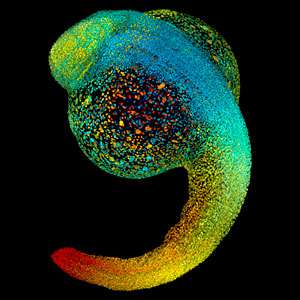Protein influence on early heart development could lead to better regenerative therapies

Stem cell therapies could one day help repair heart tissue in people with cardiovascular disease. But before doctors feel confident enough to transplant these potent cells into patients, they need to better understand how heart stem cells work normally in the developing embryo. A team of researchers from Singapore and Canada have shown that a receptor needed for early heart development works through intermediate signaling molecules to modulate the activity of a key determinant of cell fate.
A detailed understanding of this molecular cross-talk could help in the derivation of specific cell types from human embryonic stem cells for regenerative medicine, says Bruno Reversade, a human geneticist at the A*STAR Institute of Medical Biology, who co-led the investigation.
The zebrafish has emerged as a powerful scientific model for studying heart development and function. From the outside, the differences between the hearts of zebrafish and humans may seem substantial, but the two species have strong similarities at the genetic and morphological levels. Because zebrafish embryos are transparent, they provide a tractable system for watching heart development in action.
Reversade teamed up with Ian Scott from the University of Toronto to examine the link between zebrafish born with no heart due to a mutation in a gene that encodes a cell-surface GPCR called the Apelin receptor. They knew that these fish had defective heart stem cells, but it wasn't clear why.
The researchers looked into the expression of genes targeted by another protein called Nodal, a known master regulator of cell fate. They found that zebrafish without a working Apelin receptor had lower levels of Nodal target gene expression at the stage of embryonic formation when Nodal activity would normally induce heart stem cells to form. However, experimentally elevating levels of the Apelin receptor increased the expression of these same targets. What's more, directly boosting Nodal activity in zebrafish that lacked the Apelin receptor was sufficient to help them develop beating hearts.
The Apelin receptor and Nodal don't seem to be working in the same cells, though. As Reversade and Scott showed, the Apelin receptor modulated Nodal signaling through two Nodal ligands, called Squint and Cyclops. Thus, the Apelin receptor seems to serve as kind of a distant rheostat for fine-tuning the Nodal pathway during the earliest stages of heart development.
Future research will help determine how turning the knob on the expression level of the Apelin receptor can aid human patients with congenital heart diseases.
More information: Ashish R Deshwar et al. The Apelin receptor enhances Nodal/TGFβ signaling to ensure proper cardiac development, eLife (2016). DOI: 10.7554/eLife.13758


















